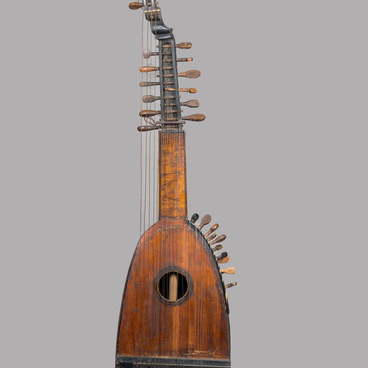The Buryat two-headed drum, known as the damaru or the damru, has a traditional hourglass shape. Its name comes from the Sanskrit word meaning “noise.” The instrument originated in South Asia, and its types varied in size, design, and playing technique.
In the 17th century, with the propagation of Tibetan Buddhism in Mongolia and then further to the Transbaikal region, the damaru and other religious musical instruments were brought to the territory of modern Buryatia.
The collection of the Russian National Museum of Music houses an instrument that has a body consisting of two resonators. They are made of the top parts of the human skull and covered with leather membranes. Beads are fastened to the ends of leather cords around the waist of the damaru.
During the rituals, the musician or monk lightly waves the drums using a twisting wrist motion. This is how the sound is produced with the small strikers beating on the two drumheads. Knots tied on the cords can also make some unique sounds.
Nowadays, the damaru is usually made of sandalwood that grows in tropical Asia and is valued for its intense red color. The membrane leather is painted with copper or other mineral salts, and special herb blends over the period of two weeks. As a result, it gets a light blue or green color. The length of such instruments varies in the range between 15 and 45 cm.
The damaru is related to the main concepts of Buddhist philosophy. According to traditional mythology, the deity Shiva holds this instrument in one of its many hands during the Tandava, or Tandava Natyam — a divine dance which symbolizes the eternal cycle of creation and destruction in the universe.
Legend has it that all the sounds of the Sanskrit alphabet originated from the sound of Shiva playing the damaru. The beat of this musical instrument symbolizes the rhythm of the creation of the entire universe, while its halves represent the male and female energy — the lingham and the yoni. The life begins its cycle when the lingam and yoni meet at the midpoint. This is why the damaru is always used as the main musical instrument in various sacred Buddhist ceremonies.
In the 17th century, with the propagation of Tibetan Buddhism in Mongolia and then further to the Transbaikal region, the damaru and other religious musical instruments were brought to the territory of modern Buryatia.
The collection of the Russian National Museum of Music houses an instrument that has a body consisting of two resonators. They are made of the top parts of the human skull and covered with leather membranes. Beads are fastened to the ends of leather cords around the waist of the damaru.
During the rituals, the musician or monk lightly waves the drums using a twisting wrist motion. This is how the sound is produced with the small strikers beating on the two drumheads. Knots tied on the cords can also make some unique sounds.
Nowadays, the damaru is usually made of sandalwood that grows in tropical Asia and is valued for its intense red color. The membrane leather is painted with copper or other mineral salts, and special herb blends over the period of two weeks. As a result, it gets a light blue or green color. The length of such instruments varies in the range between 15 and 45 cm.
The damaru is related to the main concepts of Buddhist philosophy. According to traditional mythology, the deity Shiva holds this instrument in one of its many hands during the Tandava, or Tandava Natyam — a divine dance which symbolizes the eternal cycle of creation and destruction in the universe.
Legend has it that all the sounds of the Sanskrit alphabet originated from the sound of Shiva playing the damaru. The beat of this musical instrument symbolizes the rhythm of the creation of the entire universe, while its halves represent the male and female energy — the lingham and the yoni. The life begins its cycle when the lingam and yoni meet at the midpoint. This is why the damaru is always used as the main musical instrument in various sacred Buddhist ceremonies.




